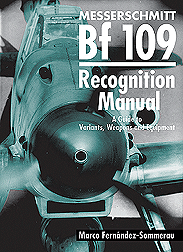|
Specialty Press |
|
Messerschmitt Bf-109 Recognition Manual A Guide to Variants, Weapons, and Equipment by Marco Fernandez-Sommerau |
|
Reviewed By Chad Richmond, #10346 |
|
|
|
MSRP $59.95 USD This 224 page volume could easily be called “Everything You Ever Wanted To Know about the Bf109 But Were Afraid to Ask”. There’s not much that is not included. The only disappointment (if there were such a thing) is that there is no color. However, the majority of the more than 500 pictures in this book have never been published before. These are primarily the compilation of Eric Mombeek and Jean-Pierre Van Mol, who co-authored this volume. The book starts with a historical chronicle of the post WWI years and the clandestine ways in which Germany tried to develop aircraft during the 1920’s and early 1930’s and eventually making the choice between the He112 and the Bf109 as the fighter for Germany’s future. The ability to mass produce the airframe was the deciding point in its selection. Also covered in historical background is a short article on the improvements in the Bf109-G6 actually hurting the German’s ability to fight. Improvements in the G-6’s engine alone made it use extremely rare 100 octane gas. The author also points out that this book is about “official” variants of the Bf109. Airframes, engine variations and armament variations concocted by units in the field are not covered. He starts with the A series and moves on through all of the production series, including the werknummern (aircraft production numbers) of all of the aircraft of that type. In each case he explains the meaning of the nomenclature. In 60 pages he presents all of the variants through the Bf109J built by the Spanish up to 1958. The next 54 pages are devoted to the technical aspect of the 109. This is the section that is the modeler’s delight. Utilizing drawings and pictures taken directly from Bf109 manuals and photos of actual aircraft, virtually every detailing aspect of the 109 is covered. All of the wiring and plumbing of the various systems is covered in picture, text and drawings. This includes the armament systems as well. The one thing that was interesting to me was the amount of pictures on the ETC 50 bomb mount. This was a mount that I had spent many months trying to get pictures of in the middle 1990’s. There are no less than 16 photos of instrument panels alone. Chapter 5 is for the historian and aviation enthusiast in us all, as it is the chapter dealing with the pilots. There are only nine pages, but 22 aces are showcased in this short section. The last 70 pages of the book are devoted to a 109 gallery, which is broken down by type. As stated before, the majority of the pictures in this volume have never been published. Among these new pictures are some tremendous opportunities for conjecture on the colors of markings. There are some very unusual markings and some that are truly unique. Of particular note are the numerous pictures that are taken from an angle that clearly shows the spine of the aircraft. The reason I say these are of particular not is because they clearly show that some aircraft had clear, distinct panel lines between the fuselage clam shell panels, and others did not. So, once again to all of our self-appointed modeling experts, it depends on the particular aircraft being modeled! Photographs of many of the most popular Bf109 subjects are from the side only, so who knows for sure? This is really a great piece of reference material. Every time I pick it up I find something I missed before. This book may be purchased by calling Specialty Press at 1-800-895-4585 or by visiting www.specialtypress.com. A $4.95 shipping and handling fee is added to each order. I would like to thank John Noack of IPMS/USA for allowing me to review his book and to Karin Hill of Specialty Press who so graciously provided IPMS with this review copy. |
|
Information, images, and all
other items placed electronically on this site |
